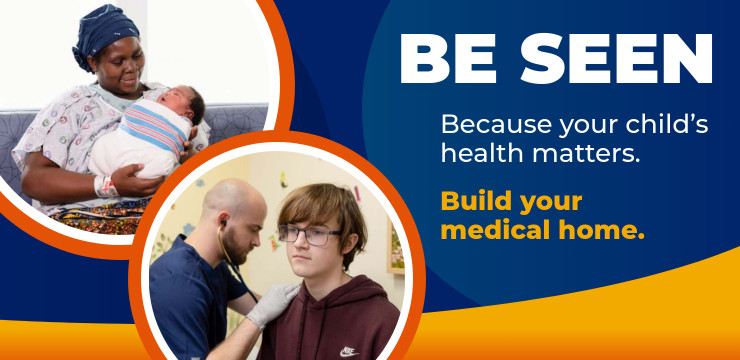Be Seen. Because Your Child’s Health Matters.

Your child’s health is more than urgent care or hospital visits; it’s having a trusted team of people who notice, listen and help at every stage. That’s the power of a medical home – a partnership, not a place or a building.
From newborn to teen, a medical home connects your child to a team you trust, from doctors and nurses, to teachers, counselors and friends who will see you, hear you and support you so your child gets the right care at the right time.
To get connected to better health, call or text 800-TEL-LINK (800-835-5465). Our 24/7 operators can provide information and referrals concerning a wide range of health services in your community.
Learn more about how to build a medical home for your family.
What is a Medical Home?
A medical home is not a clinic or a building—it’s a coordinated team. Introduced nearly 60 years ago by the American Academy of Pediatrics (AAP), the concept brings together doctors, nurses, specialists, teachers, community members and families to support a child’s physical, emotional and social well-being.
Your medical home team works together to:
- Provide regular checkups and specialty care
- Coordinate learning, family and community support
- Ensure your child’s medical and non-medical needs are met
Having a medical home means your team offers accessible, compassionate, culturally effective, family-centered, continuous and coordinated care so your child thrives in all areas of life.
For Families
How to Build Your Medical Home
Why should my child have a medical home?
Parenting is hard and having a team you trust helps make it a little easier. A medical home ensures you and your child are heard and supported when you have questions about physical health, social development, emotional well-being or behavioral concerns.
Who can I make part of my medical home?
Start with choosing a primary care physician or nurse practitioner. They coordinate care and help you manage your child’s health, answer your health questions and work with other medical experts if specialty services are necessary.
Primary care providers work in hospitals, urban and rural health systems, county health departments and in community health centers.
If you don’t have easy access to a primary care provider, people on your medical home team might include:
- Nurses, therapists, dentists, pharmacists and community health workers
- School staff, such as nurses, teachers and counselors
- Friends, neighbors and anyone invested in your child’s well-being
The key is trust and communication; when your team communicates openly, your child benefits from better-informed care and smoother coordination.
How do I build a medical home for my child/children?
If you need help finding a primary care provider where you live, there are several helpful resources available.
- ParentLink, a team of caring professionals who understand life’s challenges and the need for confidentiality.
- ParentLink’s WarmLine, direct access to family strengthening information and support.
- TEL-LINK and 800-TEL-LINK (800-835-5465), provides confidential information and referrals on maternal and child health services
- Find the local public health department in your county
- Find the nearest community health center at Missouri Primary Care Association
What if my child has special needs?
The Missouri Department of Health and Senior Services’ Bureau of Special Health Care Needs offers the Family Partnership Program, which provides statewide health care support services for children with disabilities or chronic illness.
How do I help my teen transition to adult health care?
The AAP Transition to Adult Care resources page includes information on how to help prepare your teen to manage their own health care as independently as possible.
What are the benefits of having a medical home?
- Continuity of care: One team for all your child’s care.
- Better outcomes: Children with a medical home are more likely to get the right care at the right time.
- Family-centered: You’re part of the care team—your voice matters.
- Coordinated services: Having a medical home can help connect the dots between providers, schools and services.
For Providers and Others
Who Can Provide a Medical Home?
A medical home is provided by a network of professionals and caregivers including:
- Family and specialty care physicians
- Advanced practice providers
- School teachers, nurses or counselors
- Childcare providers, community health workers and social service providers.
Being part of a medical home means coordinating care, communicating openly, and prioritizing the child’s physical, social and emotional well-being.
How to Provide a Medical Home
The American Academy of Pediatrics offers resources for providing a family-centered, team-based medical home, including guidance for children with special health care needs.
Publicity Statement
This project is funded in part by the Missouri Department of Health and Senior Services Advertising Services Contract # CS220781003 and is supported by the Health Resources Services Administration (HRSA) of the U.S. Department of Health and Human Services (HHS) under grant #B04MC52935, Maternal and Child Health Services for $12,742,189, of which $0 is from non-governmental sources. This information or content and conclusions are those of the author and should not be construed as the official position or policy of, nor should any endorsements be inferred by HRSA, HHS or the U.S. Government.
